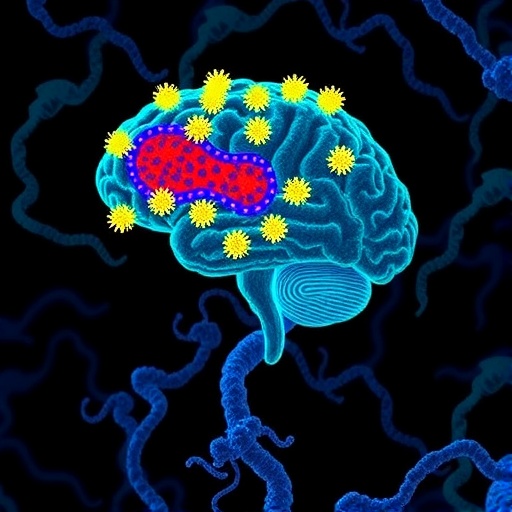In a groundbreaking advancement poised to revolutionize the treatment of neurodegenerative disorders, researchers have unveiled a novel brain-shuttled antibody designed specifically to target alpha-synuclein aggregates—a pathological hallmark of synucleinopathies such as Parkinson’s disease. The study, spearheaded by An, McInnis, Kim, and colleagues, provides compelling evidence supporting a therapeutic approach that could potentially mitigate or even reverse the progression of debilitating diseases marked by alpha-synuclein misfolding and aggregation.
Synucleinopathies represent a complex family of neurodegenerative diseases, unified by the abnormal accumulation of alpha-synuclein protein aggregates within the central nervous system. These aggregates form insoluble fibrils that disrupt neuronal function and are intimately linked with progressive motor and cognitive impairments. Historically, attempts to directly target alpha-synuclein in the brain have been thwarted by the formidable challenges posed by the blood-brain barrier (BBB), which severely restricts the passive diffusion of therapeutic antibodies from the bloodstream into the brain parenchyma.
The innovation presented in this new research stems from the engineering of a brain-shuttled antibody capable of effectively crossing the BBB. This breakthrough was achieved by harnessing receptor-mediated transcytosis mechanisms, exploiting endogenous transport pathways to ferry therapeutic agents directly into the brain. The antibody was conjugated or otherwise modified to engage with receptor systems such as the transferrin receptor, facilitating efficient traversal of the BBB while preserving its binding specificity to alpha-synuclein aggregates.
Critically, the carefully optimized antibody demonstrated high affinity and selectivity for pathological alpha-synuclein conformers without cross-reactivity to physiologic forms of the protein. This ensures that normal synaptic functions are left unaffected while pathological aggregation is neutralized. The binding leads to the disruption and clearance of alpha-synuclein fibrils, likely potentiating proteostatic mechanisms and immune-mediated degradation pathways to reverse aggregate burden within affected neural tissues.
In preclinical models, systemic administration of the brain-shuttled antibody resulted in a significant reduction of alpha-synuclein pathology in regions implicated in motor control and cognitive processing. Subsequent improvement in behavioral and neurophysiological outcomes within these models underscores the translational promise of this intervention. The research team employed rigorous longitudinal assessments, leveraging immunohistochemical, biochemical, and functional assays to substantiate both safety and efficacy across multiple synucleinopathy-relevant endpoints.
This pioneering approach addresses the long-standing translational gaps that have impeded the clinical success of earlier immunotherapeutic strategies targeting alpha-synuclein. Conventional antibodies exhibit minimal brain penetration, requiring high-dose regimens with limited central efficacy and increased systemic side effects. By contrast, the brain-shuttled design optimizes the therapeutic index and enables potent engagement of pathologic targets at a fraction of systemic exposure.
Beyond its immediate therapeutic implications, the methodology underlying brain shuttle technology could herald a paradigm shift in the treatment of a wide array of neurological diseases characterized by protein misfolding and aggregation, including Alzheimer’s disease and other tauopathies. The principle of using endogenous transport systems to ferry biologics past the BBB opens doors for targeted delivery of diverse modalities—ranging from antibodies and enzymes to gene therapies—directly into the brain’s microenvironment.
In addition to its molecular specificity, the antibody was engineered to minimize immunogenicity and extend in vivo half-life, enhancing its therapeutic window and patient compliance potential. The research also highlighted the importance of balancing efficient CNS uptake with peripheral clearance dynamics to sustain effective concentrations within disease-relevant brain regions over time.
While these results mark a significant leap forward, the study authors emphasize the need for continued investigation into long-term safety, dosing regimens, and potential immunological consequences in more complex mammalian models and ultimately human trials. The ability to alleviate alpha-synuclein pathology without unintended immunostimulatory or off-target effects remains paramount to the translation of this technology into clinical practice.
Moreover, the integration of this antibody with existing symptomatic therapies could offer a dual-pronged strategy—targeting both the underlying proteinopathy and symptomatic manifestations of synucleinopathies. Such combinatory approaches may be indispensable for addressing the multifaceted nature of Parkinson’s disease pathogenesis and progression.
The publication of these findings in npj Parkinson’s Disease is a testament to the rapid evolution of neurodegenerative disease therapeutics driven by molecular biotechnology and innovative delivery technologies. The collaboration across multiple disciplines—including immunology, neurobiology, and pharmacokinetics—exemplifies how convergent science can unravel the complexity of central nervous system disorders.
Public and scientific excitement surrounding this antibody platform is well-deserved, as the burden of Parkinson’s disease and related synucleinopathies continues to grow globally, with millions affected and limited disease-modifying options available. This research injects renewed optimism for patients, clinicians, and researchers alike, signaling a potential shift from symptomatic management toward true disease modification.
As the field moves forward, the scalability and manufacturability of brain-shuttled antibody therapeutics will be critical factors in determining their clinical and commercial viability. The ongoing optimization of antibody constructs, receptor targeting ligands, and delivery vectors will likely refine this platform further, enhancing its applicability beyond synucleinopathies to encompass a broader spectrum of neurodegenerative and neuroinflammatory conditions.
In parallel, biomarker development will be instrumental for monitoring target engagement, therapeutic response, and patient stratification in forthcoming clinical trials. The interplay between antibody pharmacodynamics, alpha-synuclein burden, and clinical outcomes must be elucidated through comprehensive biomarker panels incorporating imaging, cerebrospinal fluid measures, and peripheral markers.
Overall, the advent of brain-shuttled antibodies targeting alpha-synuclein aggregates represents a monumental step forward in the neurotherapeutics landscape. This technology elegantly addresses fundamental challenges in CNS drug delivery and paves the way for next-generation interventions that hold the promise of transforming lives impacted by Parkinson’s disease and other devastating synucleinopathies.
Subject of Research:
Article Title:
Article References:
An, S., McInnis, J.J., Kim, D. et al. A brain-shuttled antibody targeting alpha synuclein aggregates for the treatment of synucleinopathies. npj Parkinsons Dis. 11, 254 (2025). https://doi.org/10.1038/s41531-025-01117-6
Image Credits: AI Generated
DOI: 10.1038/s41531-025-01117-6
Keywords: alpha-synuclein, synucleinopathies, Parkinson’s disease, blood-brain barrier, antibody therapy, brain shuttle, neurodegenerative disease, immunotherapy




